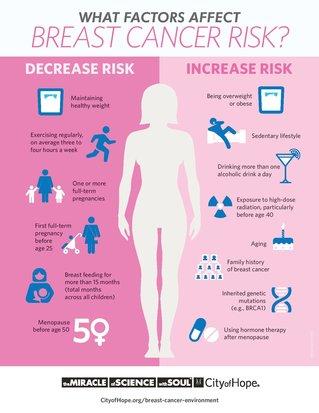Breast Cancer Risk Factors
Many factors can impact a woman’s chances of developing breast cancer. These can be divided into categories of demographic characteristics, genetic predisposition, reproductive factors, lifestyle factors and environmental factors.
Demographic Characteristics
Demographic predictors of breast cancer risk are age and race or ethnicity. Like most cancers, one’s risk of breast cancer increases as one gets older.
Further, black women have greater risk before age 40 years than white women, but after that, white women have higher risk and the highest risk overall.
Latina white women have lower risk than non-Latina white women and black women.
Breast cancer risk among Asian women is lower than that of white women and black women, but Asian women’s risk increases the longer they have lived in the United States. In fact, the breast cancer risk of U.S.-born Japanese women is nearly as high as that of non-Latina white women.
Genetic Predisposition
We have long known that women with a first degree family history of breast cancer have greater risk than women who have no such family history. Having a first degree family history means that a woman’s mother, sister or daughter has been diagnosed with breast cancer. In the 1990s, two genes were identified that define about 25 percent of the increase in risk associated with family history. Specific mutations in these two genes, known as BRCA1 and BRCA2, are associated with high risk of breast cancer.
Reproductive factors
Lifestyle factors
Lifestyle factors that increase breast cancer risk include being overweight or obese, drinking alcohol and being inactive. Regular exercise lowers breast cancer risk, whereas time spent sitting has an independent effect and increases risk. Use of hormone therapy increases breast cancer risk, especially use of combined therapy, estrogen plus a progestin (which are synthetic forms of estrogen and progesterone).
Environmental factors
Only one environmental factor is known to increase breast cancer risk and that factor is exposure to ionizing radiation. Exposure to environmental pollutants and toxic chemicals are possible risk factors for breast cancer. Any increase in breast cancer risk associated with exposure to environmental pollutants will likely depend on the amount and type of exposure, the age when the exposure occurs and the properties of the pollutant.
Our study focuses on women being exposed to two such exposures during the menopausal transition and how this exposure may impact a woman’s risk of breast cancer. The two environmental pollutants, both of which are widespread in the environment today, are polybrominated diphenyl ethers and bisphenol A.

